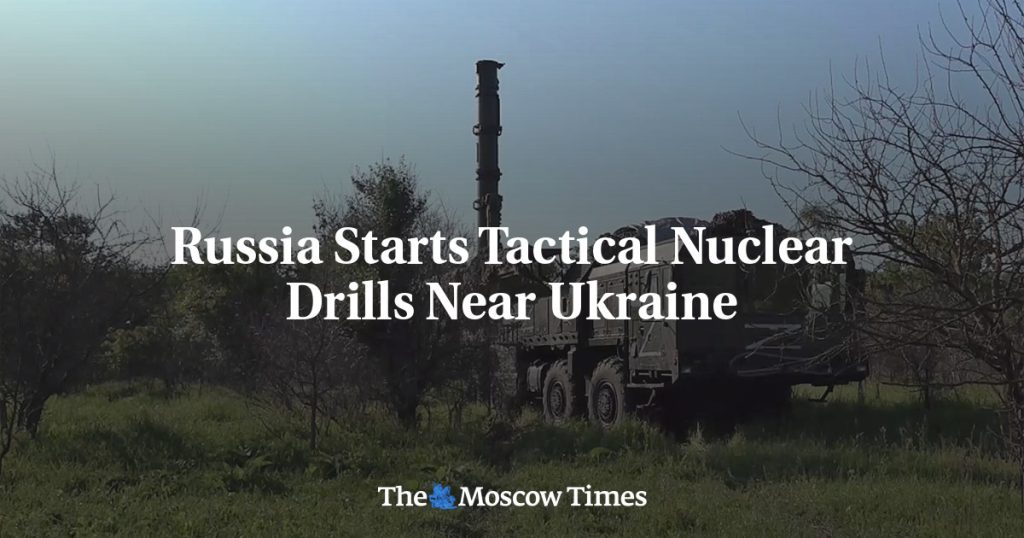Russia has recently announced the start of tactical nuclear weapons drills near Ukraine, citing Western “threats” as the reason. This move comes as Moscow has continuously emphasized its arsenal of nuclear weapons and readiness to deploy them if necessary during its ongoing offensive on Ukraine. The West has criticized Russian President Vladimir Putin for what it perceives as irresponsible nuclear saber-rattling. The drills are taking place in Russia’s Southern Military District, which borders parts of Ukraine that Moscow claims to have annexed and serves as the headquarters for its offensive operations in Ukraine.
The drills are intended to test the readiness of personnel and equipment of non-strategic nuclear weapons combat units to defend the territorial integrity and sovereignty of Russia. A statement from the Defense Ministry described the drills as a response to provocative statements and threats made by certain Western officials. The decision to conduct these drills came after statements by French President Emmanuel Macron and British Foreign Minister David Cameron regarding NATO troops deploying to Ukraine and Kyiv’s right to fire missiles at Russian territory. The Southern Military District, where the drills are taking place, includes the Crimea, Donetsk, Kherson, Luhansk, and Zaporizhzhia regions.
Footage published by the Defense Ministry showed trucks carrying missiles to a field for launch system preparation and troops at an airfield getting ready to load a bomber with a nuclear warhead. This is said to be the first stage of the drills, involving the practice of loading launch vehicles, driving to designated launch sites, and loading planes with hypersonic Kinzhal missiles. The Ministry did not indicate whether any test firings had occurred. Tactical nuclear weapons, also referred to as non-strategic nuclear weapons, are specifically designed for battlefield use and can be delivered via missiles. The drills serve as a demonstration of Russia’s military capabilities in the region and a response to perceived threats from the West.
The location of the drills, close to Ukraine, underscores Russia’s commitment to its offensive operations in the region and its readiness to defend what it considers to be its territorial interests. The decision to conduct these drills in the Southern Military District, where Russia has already annexed parts of Ukraine, sends a clear message to the West regarding Russia’s military capabilities and willingness to respond to perceived provocations. By showcasing its readiness to deploy tactical nuclear weapons, Russia is asserting its dominance in the region and sending a warning to those who may challenge its actions in Ukraine. The drills also serve as a reminder of the ongoing conflict in Ukraine and the significant role that Russia continues to play in the region.
As tensions escalate between Russia and the West over the situation in Ukraine, the drills serve as a provocative display of military power by Moscow. By conducting tactical nuclear weapons drills near Ukraine, Russia is sending a message that it will not back down in the face of perceived threats from Western powers. The use of nuclear saber-rattling as a deterrent against potential aggression highlights the dangerous escalation of tensions in the region and the potential for further conflict. The ongoing offensive operations by Russia in Ukraine, coupled with the threat of nuclear weapons, raise concerns about the stability and security of the region and the potential for a broader conflict to break out.
The drills also highlight the challenges facing international efforts to resolve the conflict in Ukraine and establish a lasting peace in the region. The response from the West to Russia’s military maneuvers will be closely watched, with potential implications for the broader security landscape in Europe. The use of nuclear weapons as a means of coercion and intimidation poses a significant threat to regional stability and underscores the need for diplomatic solutions to the ongoing crisis in Ukraine. The international community must work together to de-escalate tensions, prevent further military provocations, and find a peaceful resolution to the conflict that respects the sovereignty and territorial integrity of all parties involved.


